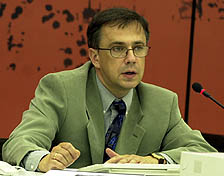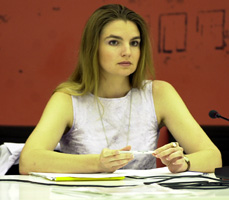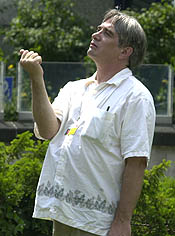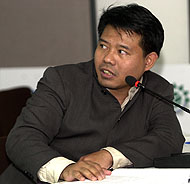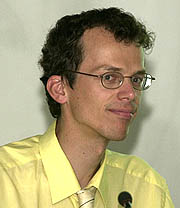|
|
|||||||||||||||||||||||||||||||||||
|
|||||||||||||||||||||||||||||||||||
|
Events convened on Monday, 23 July 2001 |
|
Measuring
and managing GHG emissions: RAO UESR
Presented by Environmental Defense
Alexander Golub, Environmental Defense, presented the results of an independent expert review of the greenhouse gas (GHG) emissions inventory of the Russian Joint Stock Company - Unified Energy System of Russia (RAO UESR). RAO UESR is one of the world's largest electric utilities and is responsible for 30 percent of the Russian Federation's GHG emissions. Golub expressed concern about the tremendous growth in emissions in the Russian Federation, and stressed the need for capacity building, robust regulation, and the introduction of economic incentives for GHG emissions reductions. He noted that reductions in GHG emissions have many associated benefits, including reductions in SO2 and particulate matter. Golub explained that the independent expert review examined inventory methodology and systems for the collection and processing of primary data on fuel consumption, identified critical factors affecting inventory uncertainty, and formulated recommendations for future steps to develop a corporate inventory. He stressed the importance of creating an emissions inventory. He concluded that RAO UESR has a solid foundation for establishing transparent GHG reporting, creating a credible and efficient GHG management system, and determining credible targets for GHG emissions reductions. Oleg
Pluzhnikov, Ministry of Energy of the Russian Federation,
emphasized the need for a national system of monitoring, and
stressed the importance of a transparent system of data inventory
collection, which will provide assurance to foreign investors.
Marina
Martynova, RAO UESR, stated that this project is a first step
toward managing RAO UESR's emissions and will facilitate its
participation in joint implementation projects. She noted
that other companies in countries with economies in transition
can borrow the methodology used in this study to measure their
own emissions, and that RAO UESR is willing to share their
experiences. Martynova added that an analysis of the results
of the pilot monitoring system will be presented next year.
Discussion: Participants discussed: the possibility of human error in data collection; the role of the Energy Carbon Facility in a trading system; and the de-carbonization of Russian energy supplies through carbon sequestration or hydrogen power. More
information: Contact: |
Presented by the Indigenous Peoples Forum on Climate Change
Indigenous peoples gathered in front of the Maritim Hotel to celebrate in prayer what they considered a "small step" taken toward protecting and respecting Mother Earth. Robert Gough, Intertribal Council on Utility Policy, noted that indigenous peoples are now threatened not only by the problem of global climate change, but also by the decision of Parties to accept sinks in the Clean Development Mechanism (CDM). The use of sinks in the CDM, they fear, could incite the establishment of large-scale plantations that could threaten the cultural and physical survival of indigenous peoples. Gough stressed that the inclusion of indigenous peoples in the negotiation process is fundamental to the appropriate design of the CDM, and called for furthering indigenous peoples' rights in developing criteria for future sinks projects. He explained that the gathering had provided for a meeting of different indigenous cultures, and sent a prayer to the UNFCCC Secretariat to support the inclusion of indigenous peoples in the negotiation process. More
information: Contact: |
|||
|
Clean Development Mechanism: National strategy study in Indonesia Presented by the Indonesian delegation and the Hamburg Institute of International Economics in collaboration with the Deutsche Gesellschaft für Zusammenarbeit (GTZ)
High priority projects include boiler improvements, gas turbines, co-generation, utilization of flared gas, gas combined cycle, small hydropower, and low temperature co-generation. Sari explained that, based on a survey of stakeholders, strategies had been identified as priorities, including: fast-tracking small-scale projects; developing a national CDM manual and guidelines; establishing the national CDM board and clearinghouse; conducting a comprehensive baseline study; fostering investment relations; and maximizing the potential for no-regrets and low-cost projects. More
information: Contact:
|
|
PROBASE procedures for baseline standardization Presented by the Joint Implementation Network (Foundation JIN)
Axel Michaelowa, Hamburg Institute of International Economics, addressed determination of investment additionality. He stressed that commercially viable business-as-usual projects should not be eligible as CDM projects because they will not benefit developing countries. He noted that project proponents will oppose additionality, as the possibility of enhancing project revenues is limited. Michaelowa explained that a project-by-project baseline approach allows an integrated determination of additionality, for example by looking at the least-cost alternative project as a baseline or control group. He suggested that benchmarks do not capture additionality, and thus a separate additionality test is necessary. He stressed the need for clear and universal criteria for investment additionality determination. He explained that, since the net present value (NPV) of a project varies according to the amount invested, it is not possible to define a generally valid threshold NPV that draws the line between profitable and unprofitable projects. However, the internal rate of return of different investments can be compared. Michaelowa underscored the importance of the additionality test where multi-project baseline approaches are used. He suggested that quantitative criteria are optimal and can be supplemented by qualitative criteria if necessary. Katie Begg, University of Surrey's Centre for Environmental Strategy, discussed baselines in the negotiating text. She noted the difficulty in specifying baseline types in a text which applies to all project types. She stressed that any recommendations on baseline types should be internally consistent, because, for example, a project-specific baseline is not compatible with a benchmark. Begg highlighted limited crediting lifetime, or baseline renewal, as the solution, as it provides a strong safeguard against over-crediting in the case of weak baselines. She explained that detailing specific baselines in the text is not as crucial with a limited crediting lifetime, and suggested that baseline definition be country- and project-specific and involve expert input. Regarding compatibility between JI and the CDM, Begg noted that in JI, it is likely that baseline methodologies will be left to the host country, in which case transparency of procedures will be essential to ensure equity, and inconsistencies in baseline setting may introduce market distortions between hosts or mechanisms. She also stressed the need for simplified baseline and monitoring procedures to allow small-scale activities to be bundled and assessed as a single entity. More
information: Contact:
|
|
Soltherm Europe Initiative: Signing of a partnership to increase the European solar collector market Presented by the European Business Council for a Sustainable Energy Future (e5)
Gerhard Stryi-Hipp, Deutscher Fachverband Solarenergie (DFS), noted that the market for solar thermal energy increased by 50 percent in 2000, and cited three reasons for the increase: the new German Government started a subsidy programme in 1999; German solar and heating industries have become more engaged in the solar market; and there has been an increase in public awareness due to rising energy prices. Stryi-Hipp described the German solar thermal energy campaign, "Solar-na klar," which aims to increase public awareness, support solar manufacturers, and assist regional and local initiatives. He said that the campaign has been a great success thus far, and that the goal is to achieve market increases of 50 percent per year from 2002-2004. He explained that the campaign requires support from other stakeholders, including industry and government, and stressed the importance of managing demand.
Bart van der Ree, Ecofys, outlined the Space for Solar campaign, which is directed at apartments and large care centers in the Netherlands. The project aims to equip 20,000 square meters of roof area with solar collectors, which would reduce CO2 emissions by approximately 3,000 tonnes per year. He explained that the parties involved will profit from central project support, which will ensure the quality of the installations, reduce the workload of institutions, and create a price advantage through economies of scale. Van der Ree noted that the Space for Solar initiative can deliver an important contribution to the fulfillment of the country's climate change targets. To conclude the event, several solar industry and interest groups signed a Renewable Energy Partnership with European Commission. Discussion: Participants discussed: the ability of solar thermal collectors to meet the hot water needs of countries in northern climates; the potential for solar thermal water heating in JI and CDM projects; funding and subsidization of mechanisms for solar water heating; and the pay-back period of solar thermal systems in comparison to solar photovoltaic systems. More
information: Contact: |
|
|
|
| The Earth Negotiations Bulletin (ENB) on the side is a special publication of the International Institute for Sustainable Development (IISD) in cooperation with the United Nations Framework Convention on Climate Change (UNFCCC) Secretariat. The Editor of ENB on the side is Kira Schmidt <kira@iisd.org>. This issue has been written by Emily Boyd <emily@iisd.org>, Fiona Koza <fiona@iisd.org> and Kira Schmidt <kira@iisd.org>. The Digital Editors are Andrei Henry <andrei@iisd.org> and Kenneth Tong <ken@iisd.org>. Photos by Andrei Henry <andrei@iisd.org> and Leila Mead <leila@iisd.org>. Funding for publication of ENB on the side at COP-6 Part II is provided by the UNFCCC Secretariat. The opinions expressed in ENB on the side are those of the authors and do not necessarily reflect the views of IISD and funders. Excerpts from ENB on the side may be used in non-commercial publications only and only with appropriate academic citation. For permission to use this material in commercial publications, contact the Managing Editor at <kimo@iisd.org>. Electronic versions of these issues of ENB on the side from COP-6 Part II can be found on the Linkages WWW server at http://enb.iisd.org/climate/cop6bis/enbots/. | |
|
|
| © 2001, IISD. All rights reserved. |
|



